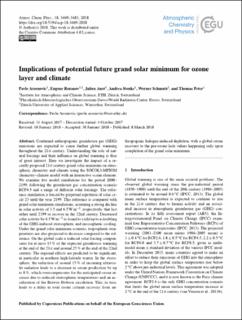Bitte benutzen Sie diese Kennung, um auf die Ressource zu verweisen:
https://doi.org/10.21256/zhaw-4656| Publikationstyp: | Beitrag in wissenschaftlicher Zeitschrift |
| Art der Begutachtung: | Peer review (Publikation) |
| Titel: | Implications of potential future grand solar minimum for ozone layer and climate |
| Autor/-in: | Arsenovic, Pavle Rozanov, Eugene Anet, Julien Stenke, Andrea Schmutz, Werner Peter, Thomas |
| DOI: | 10.21256/zhaw-4656 10.5194/acp-18-3469-2018 |
| Erschienen in: | Atmospheric Chemistry and Physics |
| Band(Heft): | 18 |
| Seite(n): | 3469 |
| Seiten bis: | 3483 |
| Erscheinungsdatum: | 2018 |
| Verlag / Hrsg. Institution: | Copernicus |
| ISSN: | 1680-7316 1680-7324 |
| Sprache: | Englisch |
| Fachgebiet (DDC): | 551: Geologie und Hydrologie |
| Zusammenfassung: | Continued anthropogenic greenhouse gas (GHG) emissions are expected to cause further global warming throughout the 21st century. Understanding the role of natural forcings and their influence on global warming is thus of great interest. Here we investigate the impact of a recently proposed 21st century grand solar minimum on atmospheric chemistry and climate using the SOCOL3-MPIOM chemistry-climate model with an interactive ocean element. We examine five model simulations for the period 2000-2199, following the greenhouse gas concentration scenario RCP4.5 and a range of different solar forcings. The reference simulation is forced by perpetual repetition of solar cycle 23 until the year 2199. This reference is compared with grand solar minimum simulations, assuming a strong decline in solar activity of 3.5 and 6.5Wm−2, respectively, that last either until 2199 or recover in the 22nd century. Decreased solar activity by 6.5Wm−2 is found to yield up to a doubling of the GHG-induced stratospheric and mesospheric cooling. Under the grand solar minimum scenario, tropospheric temperatures are also projected to decrease compared to the reference. On the global scale a reduced solar forcing compensates for at most 15% of the expected greenhouse warming at the end of the 21st and around 25% at the end of the 22nd century. The regional effects are predicted to be significant, in particular in northern high-latitude winter. In the stratosphere, the reduction of around 15% of incoming ultraviolet radiation leads to a decrease in ozone production by up to 8%, which overcompensates for the anticipated ozone increase due to reduced stratospheric temperatures and an acceleration of the Brewer–Dobson circulation. This, in turn, leads to a delay in total ozone column recovery from anthropogenic halogen-induced depletion, with a global ozone recovery to the pre-ozone hole values happening only upon completion of the grand solar minimum. |
| URI: | https://digitalcollection.zhaw.ch/handle/11475/8917 |
| Volltext Version: | Publizierte Version |
| Lizenz (gemäss Verlagsvertrag): | CC BY 4.0: Namensnennung 4.0 International |
| Departement: | School of Engineering |
| Organisationseinheit: | Zentrum für Aviatik (ZAV) |
| Enthalten in den Sammlungen: | Publikationen School of Engineering |
Dateien zu dieser Ressource:
| Datei | Beschreibung | Größe | Format | |
|---|---|---|---|---|
| 2018_Anet_Implications_of_potential_future_grand_solar_minimum.pdf | 8.67 MB | Adobe PDF |  Öffnen/Anzeigen |
Zur Langanzeige
Arsenovic, P., Rozanov, E., Anet, J., Stenke, A., Schmutz, W., & Peter, T. (2018). Implications of potential future grand solar minimum for ozone layer and climate. Atmospheric Chemistry and Physics, 18, 3469–3483. https://doi.org/10.21256/zhaw-4656
Arsenovic, P. et al. (2018) ‘Implications of potential future grand solar minimum for ozone layer and climate’, Atmospheric Chemistry and Physics, 18, pp. 3469–3483. Available at: https://doi.org/10.21256/zhaw-4656.
P. Arsenovic, E. Rozanov, J. Anet, A. Stenke, W. Schmutz, and T. Peter, “Implications of potential future grand solar minimum for ozone layer and climate,” Atmospheric Chemistry and Physics, vol. 18, pp. 3469–3483, 2018, doi: 10.21256/zhaw-4656.
ARSENOVIC, Pavle, Eugene ROZANOV, Julien ANET, Andrea STENKE, Werner SCHMUTZ und Thomas PETER, 2018. Implications of potential future grand solar minimum for ozone layer and climate. Atmospheric Chemistry and Physics. 2018. Bd. 18, S. 3469–3483. DOI 10.21256/zhaw-4656
Arsenovic, Pavle, Eugene Rozanov, Julien Anet, Andrea Stenke, Werner Schmutz, and Thomas Peter. 2018. “Implications of Potential Future Grand Solar Minimum for Ozone Layer and Climate.” Atmospheric Chemistry and Physics 18: 3469–83. https://doi.org/10.21256/zhaw-4656.
Arsenovic, Pavle, et al. “Implications of Potential Future Grand Solar Minimum for Ozone Layer and Climate.” Atmospheric Chemistry and Physics, vol. 18, 2018, pp. 3469–83, https://doi.org/10.21256/zhaw-4656.
Alle Ressourcen in diesem Repository sind urheberrechtlich geschützt, soweit nicht anderweitig angezeigt.